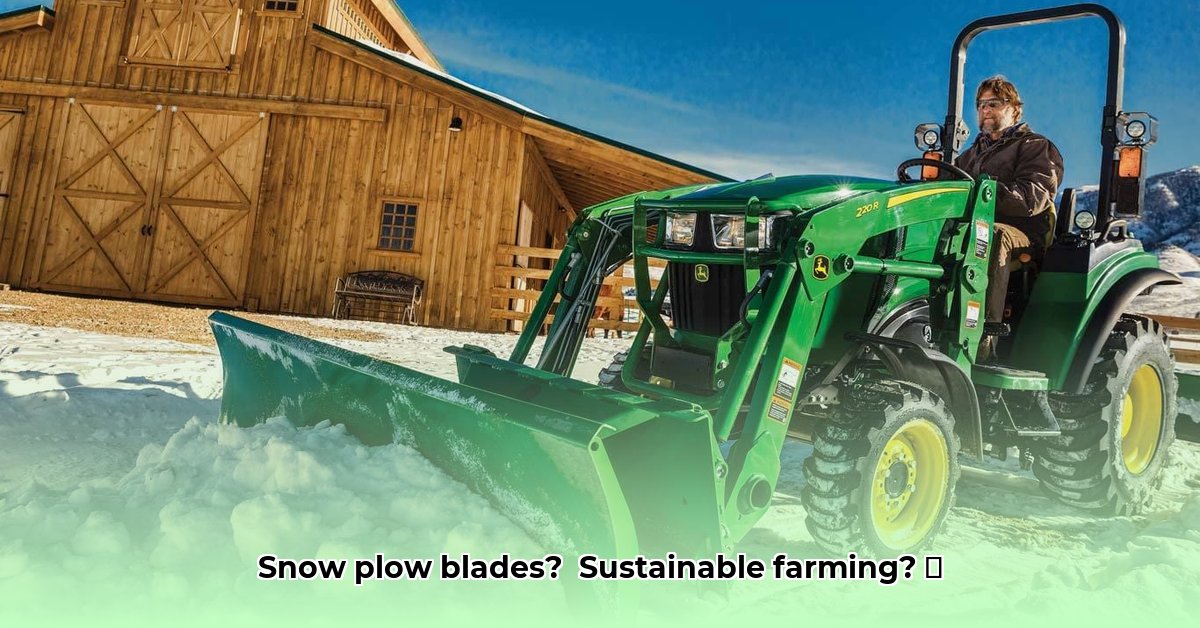
Assessing Your Needs: Blade Size and Material
Winter's arrival means snow removal becomes a critical farm operation. Selecting the right tractor snow plow blade is crucial for efficient snow clearing, minimizing environmental impact, and protecting your land. This guide helps you choose the perfect blade for sustainable winter farming.
First, honestly evaluate your farm's snow removal needs. A small farm requires a different blade than a large-scale operation. Overestimating leads to wasted fuel; underestimating means more passes, compacting soil and causing damage. Consider average snowfall; a foot of light snow differs greatly from several feet of heavy, wet snow.
Next, choose the blade material. Steel is durable and long-lasting, offsetting its higher initial cost with longevity and reduced replacement waste. However, it is heavier, potentially stressing your tractor's hydraulics. Polyurethane blades are lighter and less expensive but might not withstand rocky soil or heavy snow. For farms with rocky terrain or harsh winters, steel's superior durability makes it the more sustainable choice in the long run. Do you have a question about which material lasts the longest? Steel blades, properly maintained, can easily serve you for a decade or more. For more information, check out this helpful resource on tractor snow plow blades.
Selecting Your Tractor Snow Plow Blade: A Step-by-Step Process
Choosing the right blade requires careful planning. Follow these six steps:
Map Your Terrain: Accurately measure the area needing snow removal (fields, driveways, etc.). Include your tractor's width in your calculations.
Know Your Tractor: Consult your tractor's manual to determine its lift capacity. This prevents overloading and potential damage. Ensure the blade's three-point hitch is compatible with your tractor. Ignoring this can lead to serious accidents.
Choose Your Material Carefully: Consider your budget and typical conditions. Steel offers superior durability and longevity, minimizing waste over time, although it requires a higher initial investment. Polyurethane provides a good balance between cost and performance.
Consider Blade Design: Three main designs exist: straight, V-shaped, and curved. Straight blades are simple and effective for straightforward snow removal. V-plows efficiently move large volumes of snow from open areas. Curved blades excel in navigating tight spaces and around obstacles.
Prioritize Sustainability: A durable blade, even if more expensive initially, reduces waste and long-term costs. Inquire about blades made from recycled materials to further minimize your environmental footprint.
Consult Experts: If uncertain, consult your local farm equipment dealer. They offer expert advice tailored to your specific farm and conditions.
Steel vs. Poly: A Detailed Comparison
| Feature | Steel Blade | Polyurethane Blade |
|---|---|---|
| Durability | Extremely durable; withstands heavy use | Moderate durability; less for heavy use |
| Weight | Heavier; may require more powerful tractor | Lighter; gentler on tractor hydraulics |
| Cost | Higher initial cost; longer lifespan | Lower initial cost; shorter lifespan |
| Longevity | Many years of service | Several years, depending on usage |
| Environmental Impact | Higher initial impact, but less frequent replacement | Lower initial impact, but more frequent replacements possible |
Sustainable Snow Removal: Beyond Blade Selection
Choosing the right blade is crucial, but sustainable snow removal involves more. Consider these best practices:
- Strategic Snow Placement: Pile snow to avoid soil compaction and drainage blockages. Consider using already existing areas to lessen the impact on your land.
- Minimize Passes: Efficient route planning reduces fuel consumption and soil compaction.
- Maintain Your Blade: Regular cleaning and storage prevent rust and extend blade life.
The Future of Sustainable Snow Plow Blades
Research into more environmentally friendly materials is ongoing, with recycled steel and innovative polymer blends showing promise. Future blade designs aim to further minimize soil compaction. Stay updated on these advancements to optimize your sustainable farming practices.
Key Takeaways: Minimizing Soil Compaction
- Blade material significantly impacts soil compaction. Heavier steel blades increase compaction compared to lighter but less durable polyurethane blades.
- Proper blade thickness is crucial for effective snow removal and minimizing damage. Avoid blades that are too thick, as they increase pressure on the soil.
- Matching the plow attachment to your tractor is essential for safe and efficient operation, reducing the risk of soil compaction from uneven pressure.
- Regular maintenance extends blade life and reduces environmental impact by reducing replacements.
By carefully considering these factors, you can select a snow plow blade that optimizes efficiency and minimizes your farm's environmental impact throughout the winter months. Remember, sustainable practices are an investment in the future health and productivity of your land.